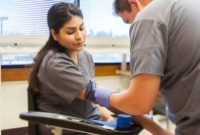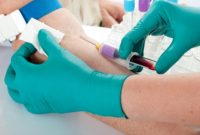In order to be a phlebotomist, you should have a number of skills to support you obtaining employment. When you apply for a job as a phlebotomist in a hospital or healthcare, you may need to fill the form that contains a list of phlebotomist skills that you have.
In case of filling a phlebotomist skills form, you may need to place a check in the skill that you have and leave it blank on the skills you do not master. To know the kinds of phlebotomist skills available in the form, we’ll show them for you below!
Where to Download Phlebotomist Skills Checklist Form in PDF?
If you want to know what skills are available on the phlebotomist skills checklist form, you may need to download the form first. You definitely can download the phlebotomist skills checklist form here.
After the form is open, you just simply click on the ‘Down Arrow’ icon at the top right of your screen. Once clicking the icon, you may need to determine in which folder you will save this form. Then, click the ‘Save’ button.
Once the downloading process is completed, you can then open the file and see what you can find on the form. If you want to print the form, you can just click the ‘Printer’ button. To print the form, make sure the printer has been connected to your PC or laptop. Before you print, you should save the form first. After that, you can now download the form.
What Can You Find on the Phlebotomist Skills Checklist Form?
The phlebotomist skills checklist form aims to assess your professional proficiency and rate your skill level as accurately as possible by placing a check. On phlebotomist skills checklist form, there are a number of skills that you should fill to represent your own skill, here are they:
Skill on Theory & Principles Relate to
- Hematology
- Chemistry
- Body Fluids
- Blood Bank
- Microbiology
- Immunology
- Basic Laboratory Procedures
- Basic Laboratory Safety
- Standard Operating Procedures
- Sources of Error in Lab Testing
- Computerized Databases
Principles Related to Safety:
- Data Security
- Patient Confidentiality
- Quality Assurance
- Body Mechanics
- Bloodborne Pathogens Exposure Plan
- Personal Protective Equipment (PPE)
- Hand Washing
- Standard Precautions
- Tuberculosis Exposure Plan
- Radiation Safety
- Hazardous Materials & MSDS
General Venipuncture Method:
- Vacationer Method
- Syringe Method
- Butterfly Method
- Blood Culture Bottles
- Therapeutic Drug Monitoring
- Bleeding Times
Knowledge of Appropriate Blood Tubes:
- Blood Cultures
Special Populations:
- Mastectomy
- Damaged Veins
- Occluded Veins
- Sclerosed Veins
- Burned Areas
- Scarred Areas
- Dialysis
- Heparin Locks
- Hickman Catheter
- Port-A-Cath
- Blood Alcohol
- Glucometer Systems
- Cardiac Arrest
Pediatric Phlebotomy procedures:
- Microcapillary Skin Puncture
- Heel Stick
- Neonatal Screening
- Finger Stick
- Venipuncture
Evaluate Lab Data:
- Assess Accuracy of Test Procedures
- Recognize/ report Abnormal Results
- Recognize Need for Additional Testing
Knowledge of Appropriate Blood Tubes cont:
- Red Topped (Plain)
- Light Blue Topped (Coagulation)
- Serum Separation (Tiger Top, Speckled, etc)
- Green Topped (Heparin, Ammonia)
- Purple Topped (EDTA)
- Gray Topped (Fluoride, Potassium, Oxalate)
- Brown Topped (Lead)
Accurately Identify (ID) Patients:
- Inpatient Identification
- Outpatient Identification
- ID of Infants & Young Children
- Emergency Department Patient ID
Procedure
- Greet Patients & Explain Procedure
- Test Requisitions
- Supplies for Venipuncture
- Positioning Patient
- Venipuncture Sites
- Warming the Puncture Sites
- Tourniquet Application
- Tourniquet Removal
- Decontamination of Puncture Site
- Order of Specimen Collection
- Invert Tube Post Draw
- Apply Site Pressure Post Draw
- Bandage Post Draw
- Proper Waste/ Sharps Disposal
- Specimen ID & Labeling
- Basic Specimen Handling
- Specialized Specimen Handling (Ice, etc)
- Transportation of Specimen of Lab
Complications:
- Fainting
- Failure to Draw Blood
- Hematomas
- Petechiae
- Excessive Bleeding
- Edema
- Infections
Urinalysis & Body Fluids
- Physical Urinalysis
- Chemical Urinalysis
- Microscopic Urinalysis
- Cerebrospinal Fluids
- Other: Serous, Synovial, Feces, Semen
EMR
- Allscripts
- Cerner
- Epic
- HomeCare Home Base
- McKesson
- Meditech
- Other Computerized Documentation System
Some Skills Required to Be A Phlebotomist
In fact, there are a wide variety of skills that will be required for being a phlebotomist both the hard skills and soft skills. The hard skills are how to perform certain medical procedures and dexterity for using equipment efficiently. The soft skills are how to get rid of a patient’s anxiety and fright.
Of course, there are some skills that you should have to be a successful phlebotomist, here are they:
- Attention to Detail
A Phlebotomist commonly has a constant flow of patients throughout the day. They definitely should be precise when drawing patient’s blood and labeling and keeping track of samples. Here’s a list what you should do:
- Calculating the quantity of blood needed
- Decontaminating the puncture site
- Documenting all procedures
- Following infection control guidelines
- Locating appropriate veins for blood collection
- Maintain specimen integrity
- Preparing specimens for transport to the laboratory
- Data Entry
Most healthcare facilities and hospitals really require a phlebotomist to enter patient and specimen information on the computer. Certainly, having data entry skills is such a big plus for a phlebotomist. The data entry will work on:
- Data Management
- Accuracy
- Computer Skills
- Microsoft Office Suite
- Data Management Software
- Information Management
- Communication
A phlebotomist should be able to explain procedures to patients as clearly as possible. A phlebotomist should also listen to their concerns and questions. In fact, a lot of patients will be nervous, so strong verbal communication skills are totally needed as a phlebotomist. Here are the kinds of communication you should have:
- Oral Communication
- Nonverbal Communication
- Active Listening
- Explaining the Process of Extracting Samples
- Instructing Patients Regarding Proper Urine Collection
- Persuasion
- Writing Reports, Correspondence, and Policy
- Dexterity
This motor skill is very necessary for the phlebotomists, as they should work with their hands to handle equipment and draw blood. They should be able to draw blood efficiently and quickly with minimal discomfort for patients. The dexterity skills include:
- Close Vision
- Hand-eye Coordination
- Working Quickly
- Performing Chemical Tests
- Promoting Workplace Safety
- Empathy
The phlebotomists should have strong interpersonal skills where they should empathize with and show care and concern for patients who feel nervous. However, empathy will lead them to interact with patients successfully. The empathy skills include:
- Calming Anxious Patients
- Customer Service
- Emotional Intelligence
- Interpersonal Skills
- Patience
Okay, those are some skills that you should have if you want to be a phlebotomist. Certainly, there are still other skills to support you to be a phlebotomist.






